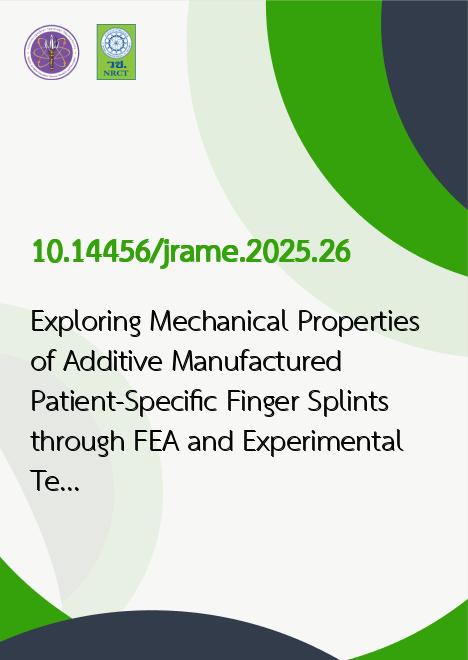
|
Exploring Mechanical Properties of Additive Manufactured Patient-Specific Finger Splints through FEA and Experimental Testing |
|---|---|
| รหัสดีโอไอ | |
| Creator | 1. S. M. Kennedy 2. K. Amudhan 3. R.B. Jeen Robert 4. A. Vignesh Moorthy Pandian1 |
| Title | Exploring Mechanical Properties of Additive Manufactured Patient-Specific Finger Splints through FEA and Experimental Testing |
| Publisher | Thai Society of Mechanical Engineers (TSME) |
| Publication Year | 2568 |
| Journal Title | Journal of Research and Applications in Mechanical Engineering (JRAME) |
| Journal Vol. | 13 |
| Journal No. | 2 |
| Page no. | JRAME-25-13-026 (p.1-12) |
| Keyword | Finger Splint, Additive Manufacturing, Finite Element Analysis, Compression |
| URL Website | https://ph01.tci-thaijo.org/index.php/jrame/index |
| Website title | Journal of Research and Applications in Mechanical Engineering (JRAME) |
| ISSN | 2229-2152 |
| Abstract | The primary objective of the study is to assess the mechanical suitability of each filament material for finger splint applications and to determine their behaviour under compressive loads. Several filament materials were used in the design and Additive Manufacturing of patient-specific finger splints. Finite Element Analysis simulations were then used to forecast mechanical responses. The simulation results are then verified and the mechanical characteristics of the splints are measured through experimental compression testing. The study's main conclusions highlight the unique mechanical properties of each filament material, such as differences in stiffness, strength, and resilience. Nylon splints showed good flexibility and toughness, while PLA and ABS splints showed differences in flexibility and moderate strength. PC splints are ideal for applications needing strong support because of their high strength and rigidity. The study has implications for the choice of filament materials for patient-specific finger splints, taking into accounts the desired mechanical properties and clinical needs. By offering useful data for improving the design and manufacture of customized finger splints, these findings advance orthopedic care. |
